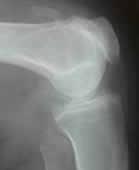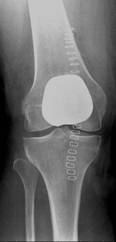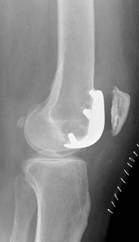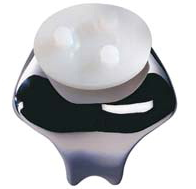Some patients can present with anterior knee pain and a feeling of scraping under their kneecaps. In these cases it may well be that the major area of arthritis within the knee is in the patello-femoral joint and not in the main joint space between the femur and the tibia. If this is the case then the patient may well be suitable for a patello-femoral joint replacement and not a total knee replacement. On occasions the x-ray appearance of the knee may underestimate the general degree of arthritis and whenever a patient is selected for this procedure it is important to make the patient aware that there is a possibility of a total knee replacement being carried out depending on direct visualisation of the articular surfaces during the operation.


Lateral and skyline x-rays showing severe arthritis
affecting the patellofemoral joint


Post-operative x-rays showing a patello-femoral replacement
The operation, like a total knee replacement, is undertaken through a midline incision over the patella and takes about 1 hour. Compared to a total knee replacement the incision is usually shorter and the surgery is less demanding for the patient. Hospital stay is seldom more than 2-3 days and full weight bearing and movement is encouraged as soon as after the surgery as possible. Full recovery of the quadriceps muscles can take up to two months afterwards.

A patello-femoral replacement has consistently been shown in research studies to be a very effective treatment for knee arthritis confined to the patello-femoral joint. However it is possible that symptomatic arthritis can subsequently develop in the rest of the knee and if this is the case then conversion to a total knee replacement will be required which is a relatively straightforward procedure. Although results following this form of surgery are extremely good the same risks can occur as those following total knee replacement and these include infection, blood clot, loosening and persistent pain.
